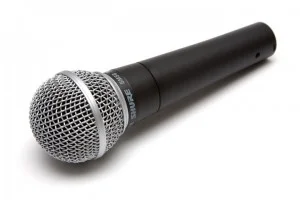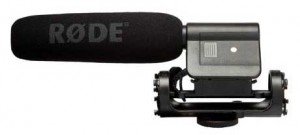What do you understand about microphone sensitivity? Of late I have seen a number of people miss-interpret the specifications of microphones, especially when it comes to microphone sensitivity. For instance when comparing two microphones, one says it has a sensitivity of -65dBV and the other says -43dBV, which one is more sensitive? The answer is the -43dBV one.
How is microphone sensitivity specified?
Let’s start by looking at a typical specification listing for a popular vocal microphone – the Shure SM58. Under the heading of Sensitivity it states:
-56.0dBV/Pa (1.6mV) 1 Pa = 94dB SPL.
I think it is easier to start at the end and work backwards.  The last bit 1 Pa = 94dB SPL is simply stating the test criteria. That is, they are using the standard of 94dB SPL is equal to one pascal. This is the normal standard used these days by most manufacturers (an older standard used one pascal as 74dB SPL). A pascal (Pa) is a unit of pressure, named after Blaise Pascal (who among other things developed the barometer). For sound levels, the standard says that a sound level of 94dB SPL (Sound Pressure Level) generates one pascal of pressure (on the microphone diaphragm).
The last bit 1 Pa = 94dB SPL is simply stating the test criteria. That is, they are using the standard of 94dB SPL is equal to one pascal. This is the normal standard used these days by most manufacturers (an older standard used one pascal as 74dB SPL). A pascal (Pa) is a unit of pressure, named after Blaise Pascal (who among other things developed the barometer). For sound levels, the standard says that a sound level of 94dB SPL (Sound Pressure Level) generates one pascal of pressure (on the microphone diaphragm).
Microphone Sensitivity in Volts
So that is our test setup, one pascal, or a sound pressure level of 94dB, is “heard” by our microphone. When this happens, the Shure SM58 will generate 1.6mV. So to compare the sensitivity of microphones, we need only to compare these figures. The higher the voltage produced at the given sound pressure level (94dB) the more sensitive the microphone is. For example if a microphone produces 15mV at the same sound level, then it is obviously more sensitive than the Shure SM58 which only produces 1.6mV.
Microphone Sensitivity in Decibels
So if that is simple enough to follow, it seems we must complicate these simple figures by converting them to decibels. Remember that a decibel is a ratio, in this case, the ratio between the produced voltage (1.6mV) and a reference level of 1 volt. This decibel ratio calculation gives us the number of -56.0dBV. That is, with the test level of 94dB SPL (1 pascal), the SM58 microphone produces a signal 56.0 decibels below one volt. These measurements are always negative. -56dBV is saying the microphone is producing a signal 56dB below the one volt reference.
To help with all this conversion from milli-Volts to decibels and back again, here is a simple calculator you can use.
Comparing Microphone Sensitivity
So there are two ways we can compare microphone sensitivity, with milli-volts or with decibels. Both ways give the same comparison. Both use a test sound pressure level of one pascal (that is, 94dB SPL). Both comparisons are easy to do without complex formulas. Simply compare the output of each microphone in milli-volts, or in decibels below 1 volt.
So let’s compare two microphones, the SM58 and the Rode Videomic.
 In the specs for the Videomic they state Sensitivity:
In the specs for the Videomic they state Sensitivity:
-38dB re 1 volt/pascal (12.6mV @ 94dB SPL) +/- 2dB @ 1kHz.
There it is, everything you would want to know about the sensitivity. The simple method: it produces 12.6mV at 94 dB SPL (compared to 1.6mV for the SM58) therefore it is more sensitive than the SM58. 12.6mV also equates to -38dBV/Pa or -38dB below 1 volt with a pressure of 1 pascal. Compared with the SM58 we can see the Rode Videomic is 18dB (56 – 38) more sensitive.
| Millivolts | Decibels | |
| Shure SM58 | 1.6mV (1 Pa = 94dB) | -56dBV/Pa |
| Rode Vidoemic | 12.6mV @ 94dB SPL | -38dB re 1 volt/pascal |
Note that the higher the negative dBV, the lower the sensitivity. That is, a mic with a sensitivity of -56dBV is less sensitive than a mic with a sensitivity of -38dBV, but more sensitive than a mic with a sensitivity of -65dBV. A more logical way to look at it is to think about how much gain will be required to amplify the test signal up to a level of one volt. For the SM58, we would need a pre-amp with a gain of 56dB. For the videomic the pre-amp needs a gain of only 38dB.
The other figures in the specifications are also worth noting. Firstly +/- 2dB, this is telling us that all Videomics are within that range of sensitivity (that is between -40dBV to -36dBV). The other interesting figure is the last bit @1kHz. This is saying these figures are true and correct at the test frequency of 1kHz, or 1000Hz. Each mic is likely to be more or less sensitive at other frequencies.
More than Microphone Sensitivity
This is also telling us there is more to a good mic than its sensitivity. We must also look at its frequency response, its tone, its maximum SPL without distortion, its directionality and its handling noise among other factors. It is also important to note that mic sensitivity is not necessarily telling us it is a good mic or not. It all depends on what the mic is being used for. We wouldn’t want to use a Videomic as the vocal mic for a rock band singer, any more than we would want to use a SM58 for distance recording. But using them for their intended use is normally ideal.
Shure has been a popular brand of microphone used by professionals for many years.
Rode is a personal favourite of mine. They make great microphones, especially for recording and video work.
This article is based on one I originally wrote for my friends at CamcorderUser.net, and has been refined by their helpful comments
